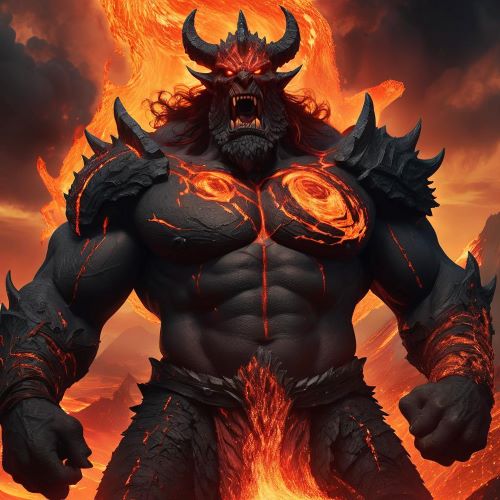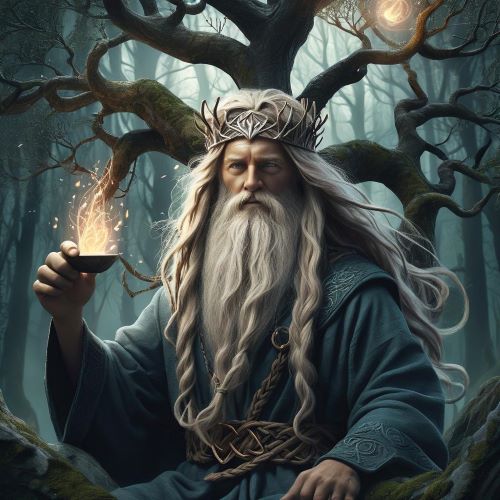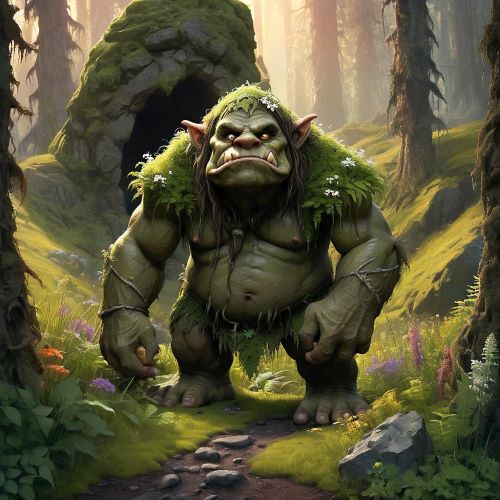Northern European Hybrids
Northern European Hybrids occupy a mysterious place in mythology, bridging the worlds of gods, humans, and animals in Finnish, Sámi, Icelandic, Estonian, and Norse traditions. These creatures combined features of multiple beings, often embodying both wonder and terror. In myth, they represented the blurred boundaries between natural and supernatural realms, reflecting humanity’s attempt to understand forces greater than themselves. Whether protectors, tricksters, or threats, hybrids were powerful symbols of transformation, embodying change, liminality, and the deep connection between people and the wild.
In Norse mythology, hybrids appear frequently, often as monstrous challenges for gods and heroes. Jörmungandr, the Midgard serpent, though primarily a serpent, carries hybrid qualities as a cosmic being that encircles the world and interacts with both divine and mortal realms. Fenrir, while a wolf, is far more than animal, possessing divine heritage that makes him a hybrid of beast and fate itself. Icelandic sagas also preserve tales of shape-shifters who could take on part-animal, part-human forms, unsettling communities with their otherworldly nature and reflecting fears of uncontrolled transformation.
Finnish mythology contains striking examples of Northern European Hybrids, particularly in the Kalevala. Heroes and villains alike often encountered beings that were neither fully human nor entirely animal. The Sampo, though not a creature, was defended by hybrid guardians and magical beings with multiple aspects. Magical shapeshifting also allowed figures to blur boundaries, becoming animal-human hybrids during battles or rituals. These stories reflected the Finnish worldview where identity was fluid, and power often came from the ability to cross natural and spiritual thresholds.
In Sámi tradition, hybrids often appear through shamanic practices, where humans transformed into part-animal forms to travel between worlds. Shamans could take on attributes of birds, reindeer, or fish, symbolizing their ability to move across boundaries that ordinary humans could not. Some myths describe beings who embodied both animal and human traits, existing as liminal guardians or guides. These hybrids underscored the Sámi understanding that survival depended on harmony with the natural world and its spirits, and that transformation was part of spiritual power.
Estonian folklore also speaks of hybrid creatures, often connected to the land and its supernatural guardians. Tales tell of beings like Näkki, a water spirit sometimes appearing as part human, part fish, who lured the unwary into lakes and rivers. Other stories describe forest guardians who blended human and animal traits, warning people to respect the sacred balance of the wilderness. These hybrids combined fear and fascination, embodying both the dangers of nature and its sacred mysteries. Across Northern Europe, hybrids remain symbols of liminality and transformation, reminding us of the ancient belief that the boundaries between humans, animals, and gods were never fixed but always shifting.
Northern European Hybrids occupy a mysterious place in mythology, bridging the worlds of gods, humans, and animals in Finnish, Sámi, Icelandic, Estonian, and Norse traditions. These creatures combined features of multiple beings, often embodying both wonder and terror. In myth, they represented the blurred boundaries between natural and supernatural realms, reflecting humanity’s attempt to understand forces greater than themselves. Whether protectors, tricksters, or threats, hybrids were powerful symbols of transformation, embodying change, liminality, and the deep connection between people and the wild.
In Norse mythology, hybrids appear frequently, often as monstrous challenges for gods and heroes. Jörmungandr, the Midgard serpent, though primarily a serpent, carries hybrid qualities as a cosmic being that encircles the world and interacts with both divine and mortal realms. Fenrir, while a wolf, is far more than animal, possessing divine heritage that makes him a hybrid of beast and fate itself. Icelandic sagas also preserve tales of shape-shifters who could take on part-animal, part-human forms, unsettling communities with their otherworldly nature and reflecting fears of uncontrolled transformation.
Finnish mythology contains striking examples of Northern European Hybrids, particularly in the Kalevala. Heroes and villains alike often encountered beings that were neither fully human nor entirely animal. The Sampo, though not a creature, was defended by hybrid guardians and magical beings with multiple aspects. Magical shapeshifting also allowed figures to blur boundaries, becoming animal-human hybrids during battles or rituals. These stories reflected the Finnish worldview where identity was fluid, and power often came from the ability to cross natural and spiritual thresholds.
In Sámi tradition, hybrids often appear through shamanic practices, where humans transformed into part-animal forms to travel between worlds. Shamans could take on attributes of birds, reindeer, or fish, symbolizing their ability to move across boundaries that ordinary humans could not. Some myths describe beings who embodied both animal and human traits, existing as liminal guardians or guides. These hybrids underscored the Sámi understanding that survival depended on harmony with the natural world and its spirits, and that transformation was part of spiritual power.
Estonian folklore also speaks of hybrid creatures, often connected to the land and its supernatural guardians. Tales tell of beings like Näkki, a water spirit sometimes appearing as part human, part fish, who lured the unwary into lakes and rivers. Other stories describe forest guardians who blended human and animal traits, warning people to respect the sacred balance of the wilderness. These hybrids combined fear and fascination, embodying both the dangers of nature and its sacred mysteries. Across Northern Europe, hybrids remain symbols of liminality and transformation, reminding us of the ancient belief that the boundaries between humans, animals, and gods were never fixed but always shifting.





